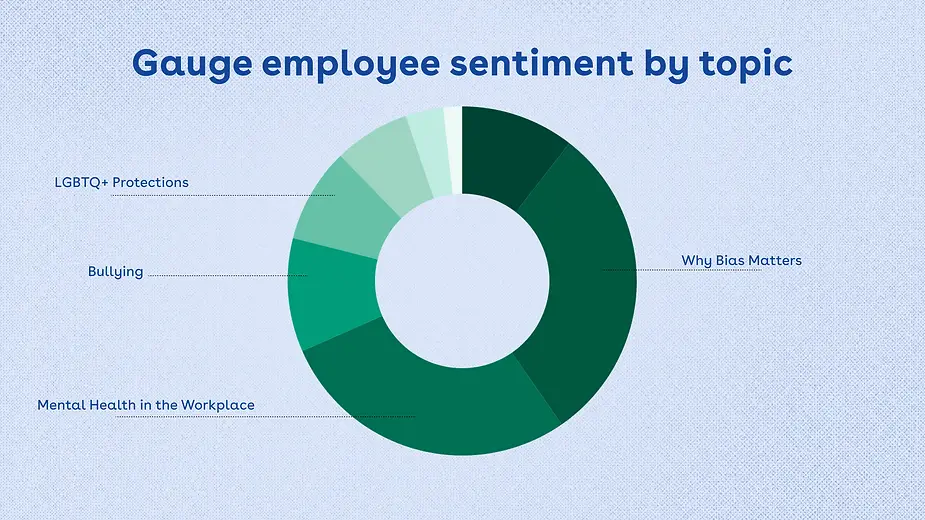Imagine this scenario. Your CEO comes to you and asks for a status update on how your employees are doing. What's morale like? Do people feel empowered to succeed? Are there any major challenges we need to keep an eye out for?
To which you respond: I’ll send out a survey and get you some answers!
And don’t get me wrong: Surveys can act as a great source of data. The problem that typically crops up, however, is that most companies do surveys wrong. They either over-survey their employees, or their survey principles aren’t based on gathering tangible, honest answers. What HR leaders are left with is 150 survey responses full of open-ended answers and little data to measure progress on, or employees who don’t even participate in the surveys – leaving leaders (again) with little to no data to act on.
When done right, your employee surveys should give you better insights into employee data, employee sentiment, and employee morale. (For an example of what "right" looks like, download Ethena's manager survey template here.)

When done wrong, employee surveys lead to survey fatigue, misleading data, and even an erosion in trust.
Let’s look at a couple of classic, employee survey no-nos.
7 employee survey no-nos
1. Too many employee surveys
Also known as “survey fatigue,” even if you’re just sending a pulse survey, companies that fall into this employee survey no-no tend to survey for everything, all the time, once a month … it’s the worst.
Why this doesn’t work: Employees will eventually stop participating. It’s just too much.
One month between surveys isn’t enough time to measure progress. You need at least 6 months between surveys to actually come up with a plan and effect meaningful change.
Try instead: Don’t run surveys any sooner than 6 months apart. And only run surveys for the big picture, big bucket things you really need to survey on (i.e. employee engagement and manager effectiveness). There are other ways to get the rest of the data you’re looking for. Examples include:
- Manager-direct report 1:1s — Have all your managers ask the same question at their next 1:1 and report back with any flags
- Manager trainings — Especially if you run live sessions, use interactive activities to suss out any concerns or suggestions
- Employee trainings — Ask pulse check questions periodically throughout your trainings, i.e. “Scale of 1 - 5, how comfortable do you feel offering peer feedback?” Not only will this get you the data you’re looking for; it’s also a great way to kick off a meaningful conversation
- Consider a live one-question poll during town hall
Sure, this sort of data collection is far less measurable over time, but that’s okay. These are in-the-moment health checks; you don’t need to benchmark for everything, all the time.
2. Overly long employee surveys
I get it. Especially with a once-a-year engagement survey, you’re trying to squeeze everything in! With this survey no-no, you wind up with an 80-question survey that takes your employees two hours to complete.
Why this doesn’t work: No one’s gonna do it; employees are busy — they’re gonna take one look at how long it is, and close right out of the survey. Also, that’s a crap ton of data to parse through. How the heck are you going to be able to choose which things to action on?
Try instead: Be as short as possible. Do your best to identify the highest impact data worth collecting, and stick to 20 scale-based questions at most.
3. Surveys that ask questions you’re unwilling to take action on
This is a big one, especially if the results come in poorly. Here’s an example: you ask employees to weigh in on whether or not they’d like to switch to a 4-day workweek even though you already know this is not something you’ll ever consider. Or a more prevalent example is probably a question around updates to perks or benefits, even though you know your company is not going to change these regardless of employee responses.
Why this doesn’t work: If you ask for feedback, you’re implicitly message-signaling that this is something you’re open to exploring. Don’t give false hope or mislead employees by asking about something you’re not going to take action on. If you’re not willing to budge, just say so and explain why instead of asking for feedback.
For the record: Sometimes companies have to make decisions the majority of their employees would have wanted differently (i.e. I bet all our employees would love to have 100 days of PTO, but guess what? That’s just not on the table for us.)
Try instead: Leave room to learn more about those extras you might not be willing (or able) to act on with open-ended questions at the end of the survey — but be sparing with these. Seriously, just one or two open-ended questions. No more. Maybe something like:
- “What didn’t we ask that we should have?”
- “What are we doing most effectively as a company?”
- “If we prioritize nothing else, what do you believe is our most critical need as a company today?”
And make sure you’re company is ready to receive, and act, on some of that feedback!
4. Employee surveys that contain confusing questions
Some surveys have questions that ask for multiple things in the same breadth. One example is asking an employee if they think we have a caring and hardworking culture … if they think we’re caring but not hardworking, how the heck do they answer?
Why this doesn’t work: Garbage in, garbage out. You’ll be able to identify that there’s a problem, but you won’t be able to identify which part of the questions employees are responding to.
Try instead: Make your questions as similar in format and simple/focused as possible.
Here are a few examples:
Instead of: “Do you believe we have a caring and hardworking culture?”
Try: Separating that into two questions (one for caring, one for hard working). Or pick the one you care about most and just ask that!
Even better: Format all your questions as similarly as possible so that it’s easier — and quicker — for your employees to get through:
- I believe we have XX culture
- I believe we have inclusive benefits
- I believe we have XX
- “I believe, I believe, I believe…” get it?
Remember to focus on the individual’s sentiment; don’t ask them to guess at how other people feel:
- Bad: “I believe everyone at Ethena feels included.”
- Good: “I believe we have an inclusive culture.”
- Bad: “I believe everyone feels their voice matters.”
- Good: “I believe my voice matters.”
Asking people to guess at how others feel is going to give you inaccurate data (and also set bad expectations as a culture, to be honest). No one should be speaking for anyone else in that way, except to advocate and speak up, of course!
5. Trying to solve all the problems
Trying to act on every piece of constructive feedback you receive while trying to improve the scores for every question you asked.
Why this doesn’t work: While it comes from a good place, this is an impossible and ineffective approach. You’ll end up stretching yourself too thin, doing many things poorly, and it will look bad to your employees.
Try instead: Instead, pick 2-3 of the highest impact items to action on, communicate the why of your selection to your employees, and commit to doing those 2-3 things really well. Trust me — your employees will respond much better to you making a handful of high impact, meaningful changes than they will if you over-promise on 10 projects and then under-deliver all around.
6. You don’t follow up on employee survey results
This happens a lot more than you’d think! Maybe you’re scared of how employees will respond to the results. Maybe you don’t have the time. Maybe you just plain old forget because you’re so focused on outlining what you’re going to do with the data you’ve received.
Why this doesn’t work: Not sharing your results after asking your employees to invest the time in completing the survey is a recipe for disaster. At best, this will lead to a sense of pointlessness (i.e. "Did you even look at the data we shared?"). And at worst, it will lead to an erosion of trust (i.e. "Are you hiding something?").
Try instead: Share your results. And share the actions you’re going to take (and not take). Remember, pick only 2 - 3 high impact items — share why, commit to a deadline, and then circle back once that deadline comes, even if it turns out you fell short. And if you fell short, explain why. Trying to hide it will only make things worse, and erode trust.
And if you’re feeling nervous about a particularly low score (or suite of low scores), remember: Your employees already know how they feel. Hiding the data from them isn’t going to change that. Instead, this is an opportunity to show your employees that you see the problem, you care, you are listening, and you’re committed to taking action.
7. Questions not rooted in data
This can include having too many open-ended questions, not enough scale-based questions, or changing the questions every time.
Why this doesn’t work: The whole point of taking a survey is to collect data in a neutral, big picture way so you can make a plan of action and then measure progress over time. Each survey should serve as a benchmark to measure yourself against the next time you run it. If you’re constantly changing the questions or if your questions are all open-ended, you won’t be able to numerically track progress over time or more neutrally assess that data you’re collecting.
Because open-ended questions are inherently biased, we are psychologically inclined to notice negative things more than positive things, which means that when reading open-ended questions, not only is it hard to report on the data, it’s also pretty much impossible to actually summarize insights in a non-biased way.
Try instead: Focus on scale-based questions, limit the number of open-ended questions (1 or 2), and include an NPS-geared question.
NPS questions are great indicators of employee sentiment and employee morale. Include a question like: “I would recommend XX company as a great place to work,” so that you can get a more general pulse check on employee sentiment.
These are especially useful because they help gauge the overall severity of your results. Here’s what I mean: You might get really low scores to a question around your benefits offerings, which could cause you to question if this frustration is a big enough deal that it’s going to lead to turnover. An NPS question, however, could help you identify that, yes, employees are seriously underwhelmed by your benefits offerings, but they still overall love working at your company and aren’t considering leaving over it.
Measuring employee sentiment
Additionally, another tool in your toolbelt to measure employee sentiment can be Ethena. We provide easy dashboards and data insights with just a few clicks. Did your company just roll out a new training on bullying from Harassment Prevention? Measure how your employees are feeling after it was over.
Want to see if you’re making progress on diversity, equity, and inclusion initiatives? Watch the feedback come in, and use the data to reinforce certain topics one-on-one or through your managers directly.

I hope these employee survey best practices help you in your journey to gather employee data for your organization. Pro tip: If the data comes back and you find your organization is weak in upholding a healthy culture, might I suggest trying out our In Good Company manager training? We believe managers are the backbone to company cultures, so it’s essential to get this part of your organization trained up. For a limited time, it’s free to enroll your managers, so give it a spin!
Ethena is a modern compliance training platform that delivers current, cringe-free content that employees actually enjoy. Request a sample course to see for yourself! If you’re ready to bring complex issues to life through thoughtful real-world examples, dynamic multimedia, and actionable next steps, let’s talk to see if Ethena is right for your company.









